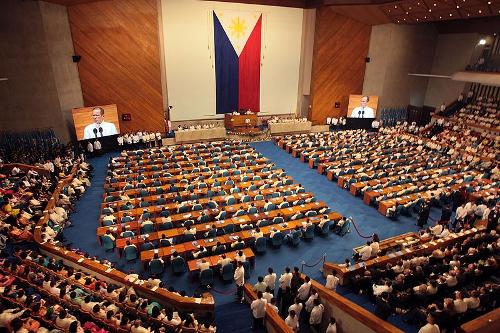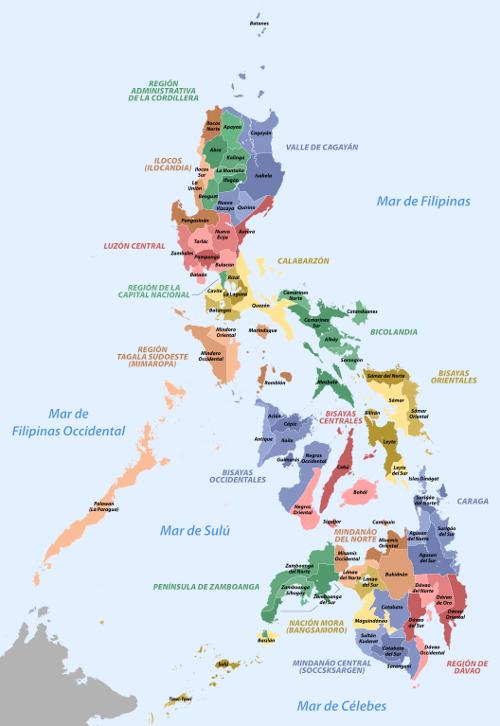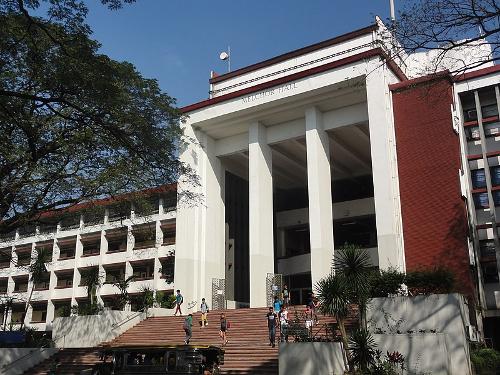PHILIPPINES
Society

Society

Cities in PHILIPPINES
| Manila |
Society
State structure
 Parliament PhilippinesPhoto: Robert Viñas in the public domain
Parliament PhilippinesPhoto: Robert Viñas in the public domain
The 1935 Constitution was amended in 1946 and suspended again in 1972. The current constitution dates from 1987 and is constructed after the American example; the separation of powers is enshrined in this constitution.
The constitution also stipulates that the president, who is elected by direct election, cannot be re-elected after a term of office of six years. The president, who is also head of government and military commander in chief, has no right to send parliament home.
The Congress, the legislative branch, consists of two Houses: a Senate with 24 members with a term of six years (half is elected every three years), and a House of Representatives of which 204 members are elected by direct elections and 50 members, representing social groups are appointed.
The president appoints members of the cabinet, who are not allowed to be members of Congress. For the current political situation see chapter history.
Administrative division
 Administrative division of the PhilippinesPhoto: Josh Lim CC 4.0 International no changes made
Administrative division of the PhilippinesPhoto: Josh Lim CC 4.0 International no changes made
The country is administratively divided into 79 provinces, headed by a directly elected governor. There is also a National Capital Region (Manila) and a Cordilleras Autonomous Region, an autonomous region for the Muslims of Mindanao. There are also some cities that are administratively outside the provinces and are called 'highly urbanized cities'.
Finally, there are a number of 'chartered cities', which fall directly under the authority of the central government.
There are approximately 1,500 municipalities, which in turn consist of more than 40,000 villages or "barangays".
| LUZON | |
| Regions | 8 |
| Provinces | 38 |
| Cities | 55 |
| Municipalities | 716 |
| Barangays | 20.476 |
| VISAYA’S | |
| Regions | 3 |
| Provinces | 16 |
| Cities | 32 |
| Municipalities | 376 |
| Barangays | 11.443 |
| MINDANAO | |
| Regions | 6 |
| Provinces | 25 |
| Cities | 27 |
| Municipalities | 404 |
| Barangays | 10.026 |
| TOTAAL | |
| Regions | 17 |
| Provinces | 79 |
| Cities | 113 |
| Municipalities | 1.496 |
| Barangays | 41.945 |
Education
 University of the PhilippinesPhoto: Patrick Roque CC 4.0 International no changes made
University of the PhilippinesPhoto: Patrick Roque CC 4.0 International no changes made
For children between the ages of seven and twelve, education is compulsory, but free. While some families send their children to private schools, most children attend public schools. The Philippine education system is very similar to the American system, only it starts in June and ends in March.
Schools generally teach in English, although Filipino and local dialects, especially in the lower classes, are also used. Approx. 90% of adults can read and write.
In the mid-1990s, more than eleven million children were in primary schools and approximately five million children in secondary education. Nearly two million students populated the universities and colleges. The oldest university is in Cebu City; the University of San Carlos from 1595.
The largest Muslim group in the Philippines are the Maranao, who mainly live in Mindanao. The city of Marawi is home to the Islamic Mindanao State University, founded by wealthy Muslims.
Dumaguete, provincial capital of Negros Oriental, is home to Silliman University, the only Protestant university in the Philippines.
Sources
Filippijnen
Het Spectrum
Philippines
Lonely Planet
Poppe, D. / Reishandboek Filippijnen
Elmar
Rodell, P.A. / Culture and customs of the Philippines
Greenwood Press
Wee, J. / Philippines
Chelsea House
CIA - World Factbook
BBC - Country Profiles
Copyright: Team The World of Info